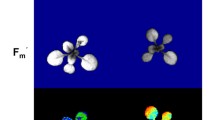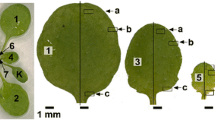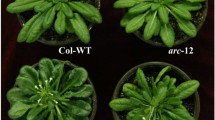Summary
In Arabidopsis thaliana the recessive gene im in homozygous condition causes variegation of the plant colour. The cotyledons contain white and green cells in variable proportions depending on the environmental conditions during germination. In the white cells all plastids are albicate, i.e., of reduced size and without regularly differentiated thylakoids; green cells contain exclusively normal chloroplasts. This pattern indicates that the gene-controlled blockade of plastid differentiation is manifested only in certain “sensitive” cells. — The present results demonstrate a dominating effect of visible light on the expression of im. With higher light intensity (more than 200 ft. candles) the cotyledons turn all white; low intensity and additional fractionation of the daily light period (40 ft. candles in pulses of 2 min and breaks of 10 min darkness in between) make them all green. Transfers of seedlings between these two light regimes during different stages of germination showed that this light sensitivity is limited for the cotyledons to a short period in between 40 and 60 hrs. after the induction of germination. During this critical phase the chloroplast differentiation in im/im-plants is irreversibly determined. For a manifestation of the mutant phenotype light of the same energy (3100 erg/cm2 sec) is more than 10-fold effective in the red (658 nm) than in the blue (445 nm) part of the spectrum. Thus the conditions which secure the development of green chloroplasts in the mutant im deviate from the normal conditions, since in the wild type the greening of etiolated leaves can also be induced by red light. The chloroplast morphogenesis in the mutant rather resembles the metamorphosis of leucoplasts into chloroplasts, which similarly can be induced only by blue light.
Zusammenfassung
Bei Arabidopsis verursacht das rezessive Gen im im homozygoten Zustand eine Grün-Weiß-Scheckung an Blättern und Stengeln. Bereits die Kotyledonen enthalten, je nach den Umweltbedingungen während der Keimung, einen wechselnden Anteil weißer und grüner Zellen. In weißen Zellen kommen nur kleinere albicate Plastiden ohne regulär differenzierte Thylakoide vor; grüne Zellen enthalten ausschließlich normale Chloroplasten. Dieses Verteilungsmuster läßt erkennen, daß die genkontrollierte Hemmung der Plastidendifferenzierung nur in bestimmten “empfindlichen” Zellen manifest wird. — Die vorliegenden Ergebnisse zeigen einen dominierenden Einfluß des sichtbaren Lichtes auf die Penetranz von im. Bei höherer Lichtintensität (mehr als 2000 Lux) werden die Kotyledonen vollständig weiß; niedere Lichtintensität und eine zusätzliche Aufteilung der täglichen Lichtphase (500 Lux in Pulsen von 2 min mit Intervallen von 10 min Dunkelheit) macht sie ganz grün. Setzt man die Keimlinge in verschiedenen Altersstadien aus hoher in niedere Lichtintensität und umgekehrt um, so erkennt man, daß die Lichtempfindlichkeit der Kotyledonen auf eine kurze Zeit zwischen 40 und 60 Std nach der Keimungsinduktion beschränkt ist. Während dieser kritischen Phase wird die Chloroplastendifferenzierung in im/im-Pflanzen irreversibel determiniert. Für eine phänotypische Ausprägung der Mutante ist energiegleiches Licht im roten Spektralbereich mindestens 10fach wirksamer als im blauen. Auch darin weichen die Bedingungen, die in der Mutante zu einer Entstehung von grünen Chloroplasten führen, vom Normalfall ab; denn etiolierte Blätter der Wildform können auch im Rotlicht ergrünen. Die Plastiden der Mutante ähneln vielmehr typischen Leukoplasten, deren Metamorphose zu Chloroplasten gleichfalls nur im Blaulicht geschieht.
Similar content being viewed by others
Literatur
Berger, Ch., u. L. Bergmann: Farblicht und Plastidendifferenzierung im Speichergewebe von Solanum tuberosum L. Z. Pflanzenphysiol. 56, 439–445 (1967).
Bergmann, L., u. A. Bälz: Der Einfluß von Farblicht auf Wachstum und Zusammensetzung pflanzlicher Gewebekulturen. I. Mitt. Nicotiana tabacum var. “Samsun”. Planta (Berl.) 70, 285–303 (1966).
—, u. Ch. Berger: Farblicht und Plastidendifferenzierung in Zellkulturen von Nicotiana tabacum var. “Samsun”. Planta (Berl.) 69, 58–69 (1966).
Björn, L. O., and I. Odhelius: Chlorophyll formation in excised roots of cucumber and pea. Physiol. Plantarum (Kbh.) 19, 60–62 (1966).
Durst, F., and H. Mohr: Phytochrome mediated induction of enzyme synthesis in mustard seedlings (Sinapis alba L.). Naturwissenschaften 53, 531–532 (1966).
Kasemir, H., u. H. Mohr: Die Regulation von Chlorophyll- und Proteingehalt in Farnvorkeimen durch sichtbare Strahlung. Planta (Berl.) 67, 33–43 (1965).
Klein, S., G. Bryan, and L. Bogorad: Early stages in the development of plastid fine structure in red and far-red light. J. Cell Biol. 22, 433–442 (1964).
Kowallik, W.: Über die Wirkung des blauen und roten Spektralbereichs auf die Zusammensetzung und Zellteilung synchronisierter Chlorellen. Planta (Berl.) 58, 337–365 (1962).
—: Die Proteinproduktion von Chlorella in Licht verschiedener Wellenlängen. Planta (Berl.) 64, 191–200 (1965).
Mohr, H., U. Meyer u. K. Hartmann: Die Beeinflussung der Farnsporen-Keimung [Osmunda cinnamomea (L.) und O. claytoniana (L.)] über das Phytochromsystem und die Photosynthese. Planta (Berl.) 60, 483–496 (1964).
—, u. E. Pinnig: Der Einfluß des Lichtes auf die Bildung von Blattprimordien am Vegetationskegel der Keimlinge von Sinapis alba L. Planta (Berl.) 58, 569–579 (1962).
Oehlkers, F.: Das Leben der Gewächse, Bd. 1. Berlin-Göttingen-Heidelberg: Springer 1956.
Ohlenroth, K., u. H. Mohr: Die Steuerung der Proteinsynthese und der Morphogenese von Farnvorkeimen durch Licht. Planta (Berl.) 59, 427–441 (1963).
Pirson, A., and W. Kowallik: Spectral responses to light by unicellular plants. Photochem. Photobiol. 3, 489–497 (1964).
Rédei, G. P.: Somatic instability caused by a cysteine-sensitive gene in Arabidopsis. Science 139, 767–769 (1963).
Rédei, G. P.: Genetic control of subcellular differentiation. In: Arabidopsis Research. Rep. Int. Symp. Göttingen 1965, S. 119–127.
—: Biochemical aspects of a genetically determined variegation in Arabidopsis. Genetics 56, 431–443 (1967a).
—: Suppression of a genetic variegation by 6-azapyrimidines. J. Hered. 58, 229–235 (1967b).
—: X-ray induced phenotypic reversions in Arabidopsis. Radiat. Bot. 7, 401–407 (1967c).
Röbbelen, G.: Untersuchungen an strahleninduzierten Blattfarbmutanten von Arabidopsis thaliana (L.) Heynh. Z. indukt. Abstamm.-u. Vererb.-L. 88, 189–252 (1957a).
—: Über Heterophyllie bei Arabidopsis thaliana (L.) Heynh. Ber. dtsch. bot. Ges. 70, 39–44 (1957b).
—: Chloroplastendifferenzierung nach geninduzierter Plastommutation bei Arabidopsis thaliana (L.) Heynh. Z. Pflanzenphysiol. 55, 387–403 (1966).
Schnarrenberger, C., u. H. Mohr: Die Wechselwirkung von Hellrot, Dunkelrot und Blaulicht bei der Photomorphogenese von Farngametophyten [Dryopteris filix-mas (L.) Schott]. Planta (Berl.) 75, 114–124 (1967).
Shropshire Jr., W., W. H. Klein, and V. B. Elstad: Action spectra of photomorphogenetic induction and photoinactivation of germination in Arabidopsis thaliana. Plant Cell Physiol. 2, 63–69 (1961).
Stocking, C. R., and A. Ongun: The intracellular distribution of some metallic elements in leaves. Amer. J. Bot. 49, 284–289 (1962).
Velemínský, J., u. G. Röbbelen: Beziehungen zwischen Chlorophyllgehalt und Chloroplastenstruktur in einer chlorina-Mutante von Arabidopsis thaliana (L.) Heynh. Planta (Berl.) 68, 15–35 (1966).
Wehrmeyer, W.: Morphologie und Morphogenese der Plastiden (Chloroplasten). 3. Wiss. Konf. Ges. Dtsch. Naturf. u. Ärzte, Probleme der biologischen Reduplikation (P. Sitte, Hrsg.), S. 203–226. Berlin-Heidelberg-New York: Springer 1966.
Ziegler, H., I. Ziegler u. H. J. Schmidt-Clausen: Der Einfluß der Intensität und Qualität des Lichtes auf die Aktivitätssteigerung der NADP+-abhängigen Glycerinaldehyd-3-phosphat-dehydrogenase. Planta (Berl.) 67, 344–356 (1965).
Author information
Authors and Affiliations
Rights and permissions
About this article
Cite this article
Röbbelen, G. Genbedingte Rotlicht-Empfindlichkeit der Chloroplastendifferenzierung bei Arabidopsis . Planta 80, 237–254 (1968). https://doi.org/10.1007/BF00392394
Received:
Issue Date:
DOI: https://doi.org/10.1007/BF00392394




